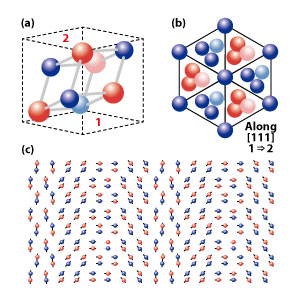R&D: Spintronics, Spin on Data Storage From A*STAR’ HPC Institute
Study into spirals of magnetic spin showcases potential of layered materials for future storage.
This is a Press Release edited by StorageNewsletter.com on May 16, 2017 at 3:08 pmTiny spirals of magnetism called skyrmions could be used as ultrahigh density energy-efficient data carriers.
Two different views of manganese silicide are shown in (a) and (b),
where the red and blue spheres represent manganese and silicon respectively.
A larger scale view of manganese silicide showing spiraling
atomic spins is shown in (c).
(Reprinted from Ref. 1, Copyright 2017, with permission from Elsevier)

Jarvis Loh, Gan Chee Kwan and Khoo Khoong Hong from the Agency for Science, Technology and Research (A*STAR) Institute of HPC (High Performance Computing) have modeled these minute spin spirals in nanoscopic crystal layers. They found that alternating layers of manganese silicide (MnSi) and cobalt silicide (CoSi) forms a promising material architecture.
“Skyrmions are nanosized entities, only tens of nanometers, so they hold the promise of higher storage density than the current technology,” said Gan.
Storage based on skyrmions would represent binary data such as ‘1’s and ‘0’s as clockwise and anticlockwise spin spirals, respectively. Skyrmions can improve energy efficiency as they can be created and manipulated with currents significantly smaller than those required for conventional magnetic hard disk technology.
Skyrmions had been experimentally observed in manganese silicide, prompting the team to explore simulations of manganese silicide in its pristine form and in combination with similar materials.
The team selected cobalt silicide because cobalt sits close to manganese in the periodic table, and its similar lattice characteristics mean it should combine well with manganese silicide. Cobalt also has strong magnetic properties — it is ferromagnetic.
The team’s simulations showed that coupling cobalt silicide to manganese silicide enables the spin spirals in manganese silicide to be engineered. “What’s interesting is that we can now vary the size of skyrmions in an easy and elegant way,” Loh said.
In the skyrmion’s center the magnetic spin of the atoms is flipped 180 degrees relative to the spin on its outside edge; between the edge and the center the spins progressively tilt between the two extremes. Critical in the size of skyrmions is the ability of the material to support high relative tilt between neighboring atoms in the lattice, which enables the skyrmion to be packed into a smaller spiral.
The team found that adding cobalt silicide layers to the manganese silicide layers increased the possible relative tilt. However there is an upper limit – for cobalt silicide layers double the thickness of the manganese silicide, the material ceased to support skyrmions and transitioned to a more conventional ferromagnetic behavior.
“One of the attractions of skyrmions as a data storage medium is their robustness,“ says Loh. “Unlike current magnetic storage, skyrmions are resistant to defects in the lattice. They are topologically protected.”
The team plans to apply their successful approach to other potential architectures, such as nanowires.
The A*STAR-affiliated researchers contributing to this research are from the Institute of High Performance Computing.
Article :Helimagnetic order in bulk MnSi and CoSi/MnSi superlattices
Journal of Magnetism and Magnetic Materials has published an article written by G.C. Loh, K.H. Khoo, and C.K. Gan, Institute of High Performance Computing, One Fusionopolis Way, #16-16 Connexis, Singapore, 138632 Singapore.
Abstract: “Skyrmions are nanoscopic whirls of spins that reside in chiral magnets. It is only fairly recent that a plethora of applications for these quasiparticles emerges, especially in data storage. On the other hand, spin spirals are the periodic analogs of skyrmions, and are equally imperative in the course of exploration to enhance our understanding of helimagnetism. In this study, a new infrastructure based on the B20 compound, MnSi is propounded as a hosting material for spin spirals; alternating thin layers of CoSi and MnSi in the superlattice form provides a facile way of varying the properties of the spin spirals across a continuum. Using first-principles calculations based on full-potential linearized augmented plane-wave (FLAPW)-based density functional theory (DFT), the spin order of bulk MnSi, MnSi film, and the CoSi/MnSi superlattice is investigated. Spin dispersion plots as a function of propagation vectors show that the spiral size changes in the presence of CoSi – we find that the size of the spiral is reduced in the superlattice with thin CoSi layers (CoSi:MnSi=1:1 thickness ratio), whilst at a larger CoSi:MnSi=2:1 thickness ratio, the material behaves as a ferromagnet. In a similar fashion, the spin moment and orbital occupancy depend significantly on the thickness of the CoSi layers. However, the exchange interaction between Mn atoms appears to be generally impervious to the presence of CoSi. Succinctly, the CoSi/MnSi superlattice could be an excellent functional material in data storage applications.“












 Subscribe to our free daily newsletter
Subscribe to our free daily newsletter
